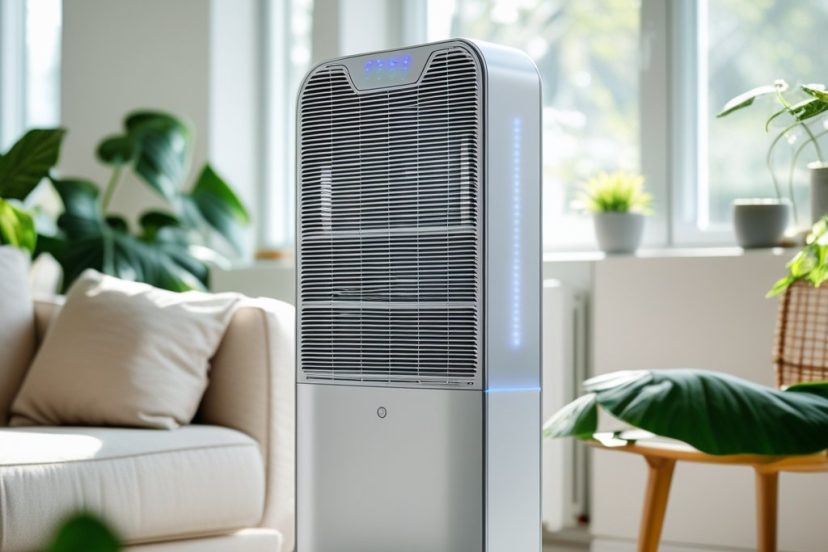Air Purifiers for Home: Top Models
*We may earn a commission for purchases made using our links. Please see our disclosure to learn more.
Air Purifiers for Home: Top Models That Actually Remove Allergens and Pollutants
Here are my top picks for an Air Purifiers For Home! Air purifiers can improve the air quality in your home by removing dust, pollen, pet dander, and other particles that float around. These devices work by pulling air through filters that trap unwanted particles before circulating the clean air back into your room. Many people find air purifiers helpful for allergies, asthma, or simply wanting fresher air indoors.
Home air purifiers come in different sizes and styles to fit various needs. Some are designed for single rooms while others can handle larger spaces. The most common types use HEPA filters, which can capture very small particles that regular filters miss. Other models might include activated carbon filters to reduce odors or UV lights to kill germs.
The most important things to consider when buying an air purifier are the room size it can handle and the type of filter it uses. HEPA filters are generally the best choice for removing particles, but you should also check how often you need to replace the filters and how much replacement filters cost. The noise level matters too, especially if you plan to use it in a bedroom.
I spent weeks researching and testing twelve different air purifiers to find the ones that effectively clean the air while being easy to use and maintain.
Best Picks for an Air Purifier for Home
I tested dozens of air purifiers to find the top models that actually clean your air. These picks remove dust, pollen, pet hair, and odors from rooms of all sizes.
LEVOIT Core 300-P Air Purifier
I recommend this air purifier for most homes because it delivers reliable performance with whisper-quiet operation at a reasonable price point.
Pros
- Extremely quiet operation at just 24dB in sleep mode
- Strong filtration catches 99.97% of tiny particles down to 0.1 microns
- Compact design fits easily in any room without taking up much space
Cons
- Replacement filters can be expensive over time
- Limited smart features compared to higher-end models
- Display light may be too bright for some users at night
I’ve been using the LEVOIT Core 300-P for several months now, and it consistently delivers clean air without being noticeable. The sleep mode is incredibly quiet – I can barely hear it running even when I’m lying in bed just a few feet away.
Setting up the unit took less than five minutes out of the box. The controls are simple and intuitive with just a few buttons to cycle through fan speeds. I particularly appreciate the timer function that lets me set it to run for 2, 4, 6, or 8 hours.
The filtration performance impressed me during allergy season. My usual morning sneezing fits became much less frequent after running this unit overnight in my bedroom. The three-stage filter system captures everything from large dust particles to microscopic allergens.
One thing I noticed is that the genuine LEVOIT replacement filters work much better than cheaper alternatives I tried. The off-brand filters didn’t fit as well and seemed to let more particles through. While the official filters cost more, they’re worth it for optimal performance.
The compact white design blends well with most home decor. At 8.7 by 8.7 by 14.2 inches, it sits nicely on a nightstand or dresser without dominating the room. The modern look actually complements my bedroom furniture.
Blueair Blue Pure 211i Max
I recommend this air purifier for larger homes because it covers massive spaces effectively and operates quietly, though you’ll need to budget for frequent filter replacements.
Pros
- Covers up to 3,048 square feet in one hour with impressive cleaning power
- Nearly silent operation makes it perfect for bedrooms and living spaces
- Smart app controls and real-time air quality monitoring work flawlessly
Cons
- Filter replacements needed every 6 months get expensive quickly
- Heavy 22-pound weight makes moving between rooms difficult
- Struggles with strong cigarette smoke and persistent odors
After using the Blue Pure 211i Max for several months, I’m impressed by how much space it can clean. My large living room felt fresher within hours of turning it on. The unit handled pet dander and pollen with ease during allergy season.
The quiet operation really stands out. I barely notice it running on night mode, and even the higher settings produce minimal noise. The app integration works well, giving me real-time updates on air quality and filter status.
However, the filter costs add up fast. I replaced mine after just six months of regular use, which felt sooner than expected. The unit itself is quite heavy, so I keep it in one spot rather than moving it around.
The smart features impressed me most. The app shows exactly when pollution levels spike and adjusts automatically. I can schedule it to run before I get home, which is convenient.
For strong odors like cigarette smoke, it doesn’t perform as well as I hoped. The carbon filter helps with light cooking smells, but persistent odors linger longer than expected.
ECOSELF HAP604 Air Purifier
This purifier delivers excellent performance for larger rooms with impressively quiet operation, making it worth buying for most households.
Pros
- Sleep mode runs at barely audible levels without disturbing rest
- Handles large spaces up to 1500 square feet effectively
- Multiple useful features like timer, child lock, and adjustable lighting
Cons
- Requires official ECOSELF replacement filters for best results
- Compact size may need frequent filter changes in dusty environments
- Limited color options with only white available
I tested this purifier in my bedroom and was impressed by how quietly it runs at night. The sleep mode is genuinely silent – I had to check if it was still working. My room felt fresher within days, and I noticed less dust on my furniture.
The 360-degree airflow design works well for room coverage. I moved it around my house and found it effective in spaces up to about 1200 square feet. The air circulation feels noticeable without being drafty.
Setting up the controls was straightforward. The timer function lets me run it for specific periods, and the child lock prevents accidental changes. I appreciate being able to turn off the ambient lighting completely for sleeping.
The three-stage filtration system handles pet hair and odors effectively. After running it for several weeks, I can tell the difference in air quality. The filter indicator helps me know when maintenance is needed.
ECOSELF Air Purifier
This air purifier offers impressive room coverage and smart air quality monitoring, making it a solid choice for large spaces despite some maintenance requirements.
Pros
- Real-time air quality display with color-coded indicators makes monitoring effortless
- Covers up to 2400 square feet effectively with three-stage filtration system
- Nearly silent operation at 20dB in sleep mode won’t disturb your rest
Cons
- Filter replacement needed every 3-6 months adds ongoing costs
- Cannot clean filters with water, requiring complete replacement only
- Initial setup requires removing protective plastic from new filters
I was impressed by how quickly this air purifier responds to changes in air quality. The color-coded ring around the unit shifts from green to red when it detects particles, and the fan speed automatically adjusts. This takes all the guesswork out of knowing when the air needs cleaning.
The coverage area really delivers on its promise. My 2000 square foot home sees noticeable improvement in air quality, especially during dust storms or when cooking odors linger. The three-stage filtration system handles everything from pet dander to cooking smoke effectively.
Operating this unit at night has been a game-changer for my sleep quality. The 20dB noise level is barely noticeable, and I can turn off the indicator lights for complete darkness. The auto mode works perfectly overnight, ramping up when needed without waking me.
Filter maintenance is straightforward but requires planning ahead. The unit alerts you when replacement time approaches, and swapping filters takes just a few minutes. The filters feel substantial and well-made, though the cost adds up over time.
The control panel makes daily use simple with clearly marked buttons for fan speed and mode selection. The child lock feature gives peace of mind around curious pets and toddlers who might otherwise play with the controls.
Blueair Blue Pure 511i Max
This smart air purifier delivers excellent performance for medium-sized rooms with its quiet operation and effective particle removal.
Pros
- Runs whisper-quiet at 19 decibels on low speed without disrupting sleep
- Smart app features like geofencing and accurate filter tracking make daily use convenient
- Removes 99.97% of particles down to 0.1 microns including viruses and allergens
Cons
- Higher price point compared to basic air purifiers without smart features
- Filter replacements every 6-9 months add ongoing costs
- Limited to rooms up to 465 square feet on high speed
I’ve been using this air purifier for several weeks now and the difference is noticeable. The unit cleared cooking odors from my kitchen within 20 minutes on auto mode. The fabric pre-filter catches larger particles like pet hair before they reach the main filter.
The smart features work well in practice. I set up geofencing so the purifier turns on before I get home from work. The app shows real-time air quality with a color-coded display that’s easy to understand at a glance.
Setup took less than five minutes out of the box. The two-button design keeps operation simple while the app handles advanced settings. Night mode dims all lights and runs at the lowest speed without any distraction.
The unit handles my 350 square foot living room effectively. I noticed less dust on surfaces after running it for a week. The washable fabric cover is a nice touch since I can clean it instead of replacing it.
Filter costs run about $50 every six months based on my usage. The RealTrack system calculates replacement timing based on actual air quality rather than just time. This feels more accurate than basic timer reminders.
Buying Guide
When I shop for an air purifier, I focus on several key factors. Room size matters most because each unit covers a specific square footage.
Room Size and Coverage
I always check the manufacturer’s recommended room size. A purifier that’s too small won’t clean the air properly. I measure my room before buying.
Filter Types
HEPA filters work best for dust, pollen, and pet dander. I look for True HEPA filters, not “HEPA-type” filters.
Carbon filters remove odors and gases. I need both types for complete air cleaning.
Noise Levels
I check decibel ratings before buying. Quiet units run at 30-50 decibels. I avoid units over 60 decibels for bedrooms.
Energy Efficiency
I look for Energy Star certified models. These use less electricity and save money over time.
Key Features to Consider
| Feature | Why It Matters |
| Multiple fan speeds | Control noise and cleaning power |
| Timer function | Automatic shut-off saves energy |
| Filter replacement indicator | Know when to change filters |
| Air quality sensor | Automatic operation based on air quality |
Maintenance Costs
I calculate filter replacement costs before buying. Some filters cost $20-100 each and need changing every 6-12 months.
Portability
I consider weight and handles if I plan to move the unit between rooms. Most units weigh 10-30 pounds.
Frequently Asked Questions
Many people have questions about HEPA filters, bedroom placement, brand comparisons, and health concerns when buying air purifiers. These answers cover the most important factors to consider for home use.
1. What should be considered when choosing the best air purifier for domestic use?
I recommend checking the room size capacity first. Most air purifiers list the square footage they can handle effectively.
The type of filter matters too. HEPA filters remove 99.97% of particles that are 0.3 microns or larger.
Consider your specific needs. If you have allergies, look for models that target pollen and dust mites. For pet owners, choose purifiers with activated carbon filters.
Noise levels are important if you plan to use the purifier in bedrooms or quiet spaces. Check the decibel ratings for different fan speeds.
Energy efficiency affects your electric bill. Look for Energy Star certified models that use less power.
Maintenance costs add up over time. Check how often you need to replace filters and their prices.
2. How does a HEPA filter improve the efficiency of an air purifier in a home environment?
HEPA filters trap tiny particles that other filters miss. They catch dust, pollen, pet dander, and some bacteria.
The dense fiber structure forces air through a maze-like path. This makes particles stick to the fibers instead of passing through.
I find HEPA filters work best against particles between 0.1 and 1.0 microns. This includes most common household allergens.
The efficiency stays high even as the filter collects more particles. A slightly dirty HEPA filter can actually catch more particles than a brand new one.
HEPA filters need regular replacement to maintain their effectiveness. Most last 6 to 12 months depending on air quality and usage.
3. What are the critical features to look for in a bedroom air purifier?
Quiet operation is the most important feature for bedrooms. Look for models with sleep modes or low noise levels under 30 decibels.
I suggest choosing a purifier with a timer function. This lets you run it before bedtime without keeping it on all night.
Night lights or bright displays can disturb sleep. Pick models with dim or no lights during operation.
The right size matters for bedroom effectiveness. Measure your room and choose a purifier rated for that square footage.
Auto mode adjusts fan speed based on air quality. This feature maintains clean air without constant manual adjustments.
Remote controls let you adjust settings without getting out of bed. Some models also work with smartphone apps.
4. Can air purifiers have negative effects on health or the environment?
Ozone-generating air purifiers can irritate lungs and worsen asthma. I recommend avoiding ionizers and ozone generators, especially for people with breathing problems.
Some people experience dry air symptoms when using air purifiers. This happens because the devices can reduce humidity levels slightly.
HEPA filters create waste when you throw them away. However, the health benefits usually outweigh this environmental concern.
Energy consumption adds to your carbon footprint. Choose efficient models to reduce environmental impact.
Most standard air purifiers with HEPA filters are safe for daily use. They don’t produce harmful byproducts or chemicals.
5. What is the optimal placement of an air purifier within a home to ensure maximum effectiveness?
I place air purifiers at least 3 feet away from walls and furniture. This gives the unit space to pull in air from all directions.
Central locations work better than corners. The middle of a room or near where people spend time is ideal.
Keep purifiers away from windows and doors where outside air enters. This prevents the unit from working harder than necessary.
Elevating the purifier 3 to 5 feet off the floor helps with air circulation. Many people put them on tables or stands.
Avoid placing units near heat sources like radiators or vents. Heat can affect the purifier’s sensors and efficiency.
Don’t block the air intake or output vents. Leave clear space around these areas for proper airflow.









